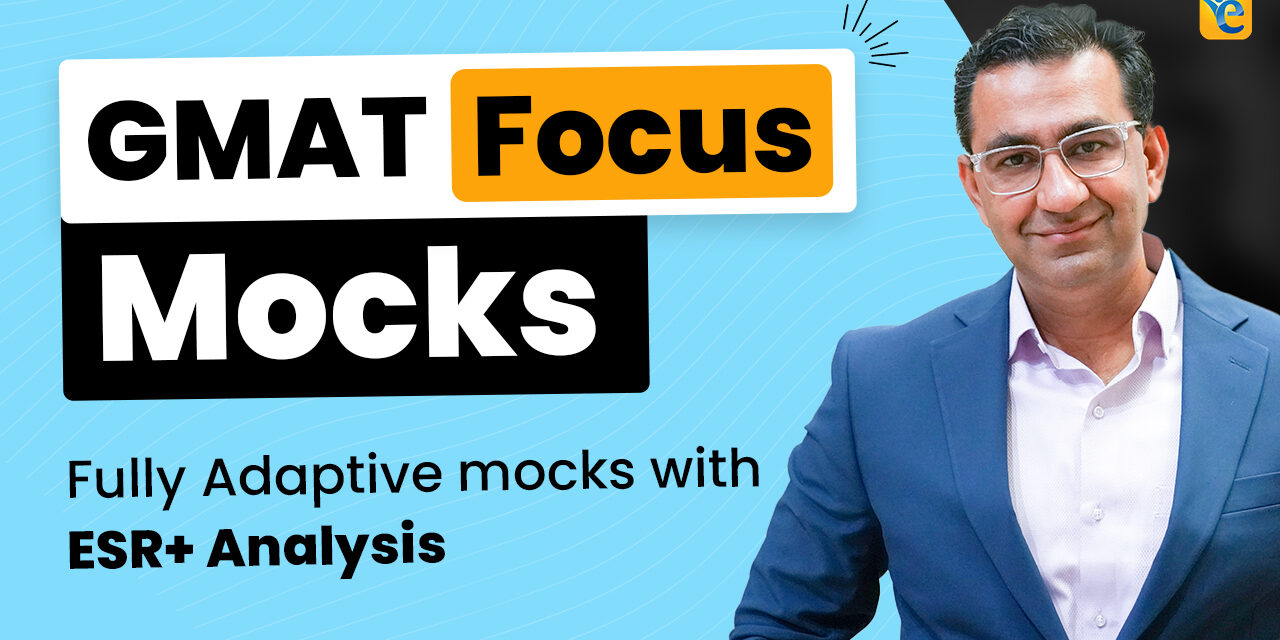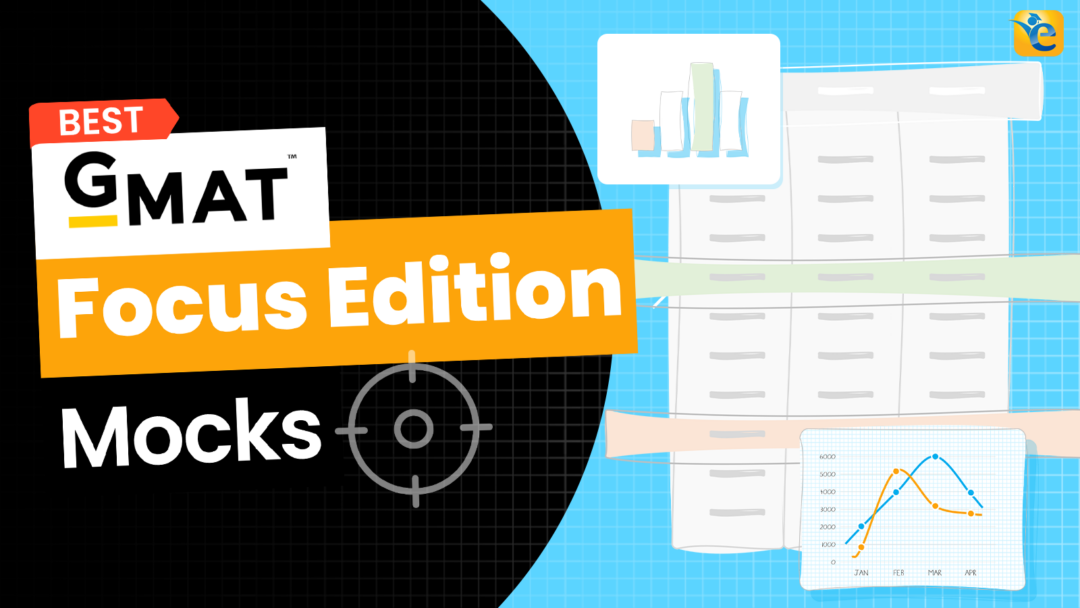Introduction
We at e-GMAT are immensely proud to announce a groundbreaking advancement in GMAT preparation with the launch of our GMAT Focus Edition mocks. This pioneering resource stands as a testament to our innovation and commitment to excellence in aiding students on their journey to GMAT success.
- Fully Adaptive Mocks: We are thrilled to provide fully adaptive mocks (question-level adaptive), ensuring that each test taker experiences a personalized and precise assessment of their current preparedness.
- Built on Deep Understanding and Extensive Research: Our mocks are crafted based on a deep understanding of the GMAT’s mechanics, drawing from our rich history of creating the most successful mocks for the Classical GMAT, and refined through more than 200 simulations conducted on the GMAT Focus Edition.
- Comprehensive Adaptive Testing Experience: Every mock is robust, containing three times the number of questions required, perfectly emulating the official GMAT adaptive testing experience.
- Optimal Question Difficulty and Mix: The advanced question picker in every mock guarantee that students are presented with questions at just the right difficulty level and the right mix of question types, crucial for an accurate assessment.
- Accurate Score Prediction with Detailed Insights: Beyond providing a reliable score prediction, our mocks offer detailed insights, including sectional scores and sub-sectional percentiles, enabling test takers to craft precise and effective improvement plans. Read the case studies at the end of this article to know more.
We are excited to be the first company to introduce such a resource for the GMAT Focus Edition, solidifying our commitment to our student’s success and affirming our dedication to empowering students to realize their highest potential on the GMAT.
- Introduction
- Creating GFE mocks – A unique challenge
- Analytics and Insights
- Summary: A mock designed to Empower you
Creating GFE mocks – A unique challenge
Official mocks – a treasure trove of insights
Delving into the intricacies of crafting GMAT Focus Edition (GFE) mock tests, one finds a nuanced landscape where the challenges and facilitations coexist, making the development process intricate and approachable. On the one hand, the official mocks for GFE offer an invaluable window into the workings of this specific edition.
- Invaluable Insight from Official Mocks: The official GFE mocks serve as a remarkable resource, offering a clear and precise window into the intricate workings of the exam, which is instrumental in crafting authentic and reliable practice tests.
- Comprehensive Data Provided: These mocks stand out by not only providing sectional scores but also delving deeper to offer sub-sectional percentiles and detailed performance analytics based on fundamental skills at both aggregate and question levels.
- Advantage Over GMAT Current Edition Resources: This level of detailed insight is notably absent in the mock tests and Enhanced Score Report (ESR) available for the GMAT Current Edition, highlighting a unique advantage in crafting mocks for the GFE.
- Better Tools for Algorithm Study: The GMAC, with the introduction of the GFE, has undoubtedly equipped educators and test prep providers with a more comprehensive toolkit for studying and replicating the exam’s algorithm, enhancing our capacity to create mock tests that are both reliable and intricately aligned with the GFE’s nuances.
Overall, while the journey of creating GFE mock tests is layered with complexities, the extensive resources and data provided by the GMAC play a pivotal role in making this task more approachable, ensuring that we are well-equipped to navigate these challenges and create mock tests that truly reflect the depth and breadth of the GMAT Focus Edition.
Why Creating GFE Mocks is More Challenging:
Creating GMAT Focus Edition (GFE) mock tests is a complex task due to several factors that introduce intricacy into the process.
- Question Complexity: Simulating an adaptive mock test requires a sophisticated question bank. The questions must be meticulously crafted, ensuring they adhere to specific criteria:
- They are accurately categorized by difficulty level.
- They test the right skills in the correct proportion across various sections.
- Increased Number of Variables: Unlike the traditional GMAT with two sections (Quant and Verbal), the GFE has three (Quant, Verbal, and Data Insights). This means satisfying numerous sub-sectional constraints within each section. Consequently, the complexity for the question picker algorithm in GFE has increased significantly, with the number of constraints increasing from 25 to 60. Anyone who has ever created a question picker will attest to the fact that every constraint adds to the complexity of implementation and multiplies the number of test cases non-linearly.
- Refined Adaptive Nature: The GFE boasts a more sophisticated adaptive algorithm compared to the current GMAT. In fact, the adaptive algorithm that the GFE uses is much more in line with the compute resources available in the 2020s rather than in the 2000s when the original algorithm was developed. Developing an approximate model of this algorithm demands increased computational complexity, adding to the challenge.
- Comprehensive Output Computations: The output screens for GFE provide over 11 ability scores, ~1.5X the number given by the current GMAT. Fine-tuning the estimation algorithm for each of these scores and rigorously testing them requires committing substantial effort and resources.
These challenges have led to a significant reduction in the availability of fully adaptive GFE mocks. Most test prep companies have chosen not to develop (as of Nov 1, 2023) practice tests for GFE, resulting in a scarcity of resources. The number of fully adaptive mocks available for GFE is expected to be only a third of what is available for the current GMAT, illustrating the substantial impact of these challenges on GFE test preparation.
| Mock Test Provider | # of GCE mocks | # of GFE mocks |
| GMAC (Official Mocks) | 6 | 6 |
| e-GMAT | 5 | 5 |
| Manhattan Prep | 5 | Not Available * |
| Kaplan | 6 | Not Available * |
| 800 Score | 5 | Not Available * |
| GMAT Club | 5 | 5 ** |
| Princeton Review | 10 | Not Available * |
* As checked on their website on Oct 30, 2023
** Estimated. GMAT Club has not provided launch dates.
Analytics and Insights
A mock test serves two essential jobs in your GMAT preparation journey, each pivotal in its own right.
Job 1: Offering a Reliable Ability Estimate The primary purpose of a mock test is to provide a trustworthy assessment of your current capabilities. This entails delivering an accurate estimate of how you would perform if you were to take the GMAT at that very moment. The precision of this estimate is crucial as it sets the stage for your ongoing preparation, guiding your understanding of your strengths and areas that need improvement.
Job 2: Identifying Areas for Improvement Beyond just assessing your performance, a mock test should illuminate the specific areas where you can enhance your skills. It acts as a diagnostic tool, diving deep into your test-taking strategies and pinpointing the exact aspects of your approach that could be optimized for better results. The goal here is to offer actionable insights that can be translated into a concrete improvement plan, helping you to target your efforts more effectively and boost your overall GMAT performance.
However, providing these actionable insights is not without its challenges, especially given the limited dataset that a single mock test represents. We need to ensure that the metrics and insights we draw from the test are based on enough questions to offer valid and reliable guidance. With GFE mocks, our goal is to strike a balance, providing you with meaningful, data-driven advice that can genuinely impact your preparation journey.
Insight 1: Sectional Gap Analysis
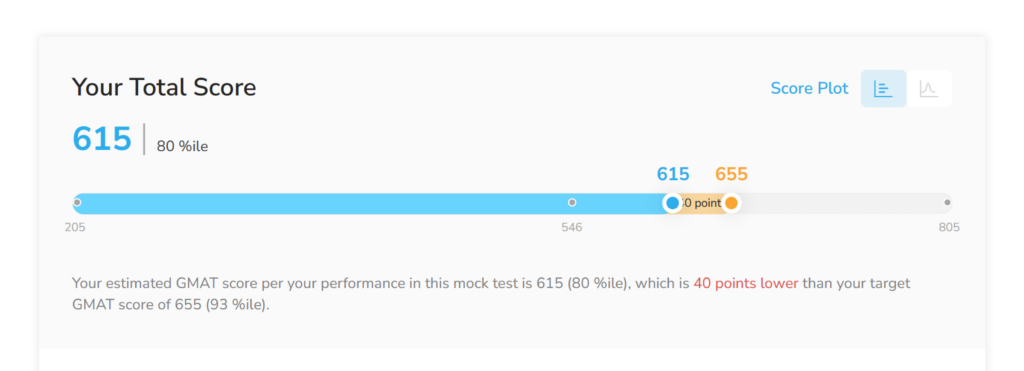
One of the primary actionable insights that our system provides is the gap analysis in the Sectional score estimates. The value of this is best illustrated using an example. Bethany aspires to achieve a score of 655 and currently stands at 615. With a regular mock, including the official mock, Bethany would deduce where she fell short and which areas need improvement. Our GFE mock, built on our PSP engine, changes that.
Consider the score report illustrated below. At a glance, Bethany can immediately discern how far off she is from her target scores across the various sections:
- Quantitative Reasoning: The student’s current score stands at 81 (equivalent to the 71st percentile). To reach their goal, they’ll need to improve by 3 points, pushing their score up to 84.
- Verbal: Here, the student scored an 80, landing them in the 60th percentile. Their aim? A score of 82. This means they’ll need to boost their performance by just 2 points in this section.
- Data Insights: Currently at 80 (which puts them in the 86th percentile), the student’s objective is a score of 81. That’s a bump of a single point.
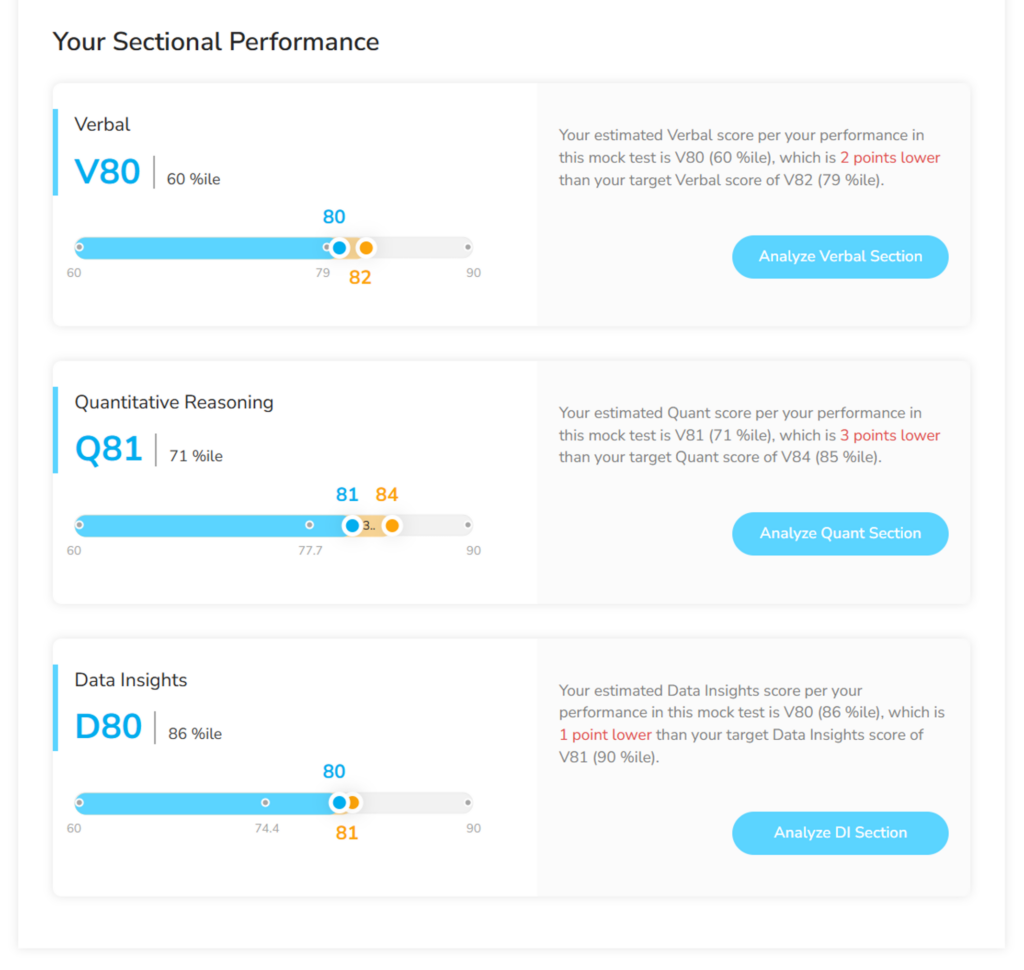
This kind of granularity in feedback is game-changing. Instead of sifting through data and making subjective interpretations, students like Bethany are handed a clear roadmap. They can see, in no uncertain terms, where their efforts need to be channeled to bridge the gap between their current performance and their aspirations. It’s not just about knowing where you stand; it’s about understanding the steps to get where you want to be.
Students can see, in no uncertain terms, where their efforts need to be channeled to bridge the gap between their current performance and their aspirations.
Insight 2 – Sub-sectional abilities help channelize energy
To delve deeper into areas of improvement, let’s zone in on the Quantitative section, where Bethany has the most ground to cover.
The Sub-sectional abilities provide an even clearer picture. As depicted in the chart below, Bethany’s proficiency in Algebra is impressive, standing at the 96th percentile. They’re right at the top tier, suggesting a near-perfect grasp of Algebraic concepts.
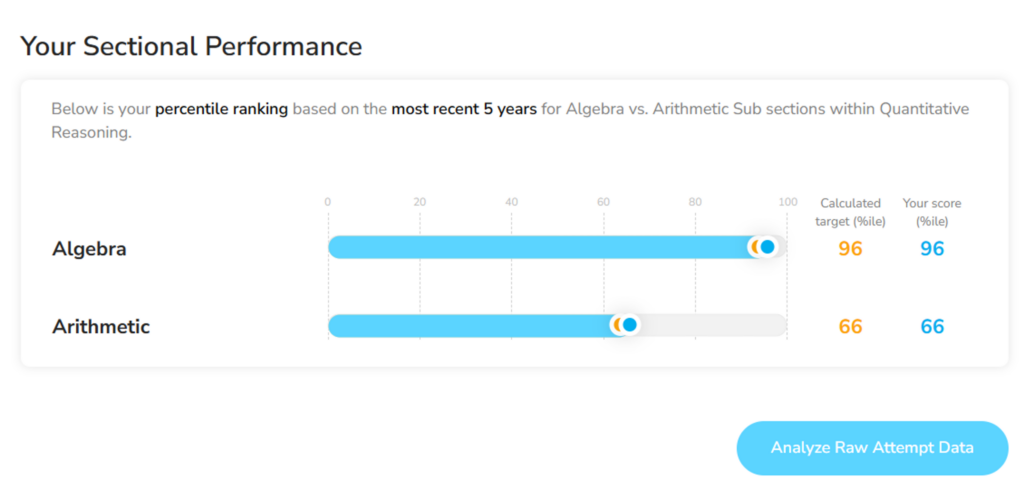
However, a stark contrast arises when we consider Arithmetic. Here, Bethany’s performance drops to the 66th percentile. While this isn’t necessarily a poor score, the discrepancy between the two subsections is evident. The potential for improvement in Arithmetic is significant, indicating this as the primary area where Bethany should focus her efforts.
By isolating and pinpointing these specific weaknesses, the student can craft a targeted study plan. Instead of spreading their energy thin over the entire Quant section, they can now channel their resources and time into Arithmetic, ensuring a more efficient and result-oriented preparation.
The potential for improvement in Arithmetic is significant, indicating this as the primary area where Bethany should focus her efforts.
Insight 3: Accuracy and Topic level Analysis – Sharpening the lens

Accuracy Analysis – Sharpening the Lens: When we dig deep into the raw data, we’re able to pinpoint the specific areas in Arithmetic where Bethany faces challenges. The above chart becomes an invaluable tool in this endeavor. By assessing her accuracy across various difficulty tiers, it’s evident that Bethany grapples with the harder Arithmetic questions. While she maintains a commendable 100% accuracy rate for Medium and Medium-Hard questions in Arithmetic, her accuracy plunges to just 33% when faced with hard questions in the same category.
Action Items: To boost her Quant score from Q81 to Q84, Bethany’s primary focus should be on elevating her accuracy in hard Arithmetic questions to a level of 60% or above.
This kind of precision in feedback is what makes a difference. Rather than a generic “you need to improve in Quant,” Bethany now has a clear direction and objective to drive her preparation forward.
Topic Level Analysis – Analyzing Mistakes at a Micro-Level for High Performers
For students who exhibit an ability of the 70th percentile or higher, such as Bethany, it’s crucial to delve deeper into sub-topic level insights. This granular analysis illuminates specific areas they need to bolster to improve further.
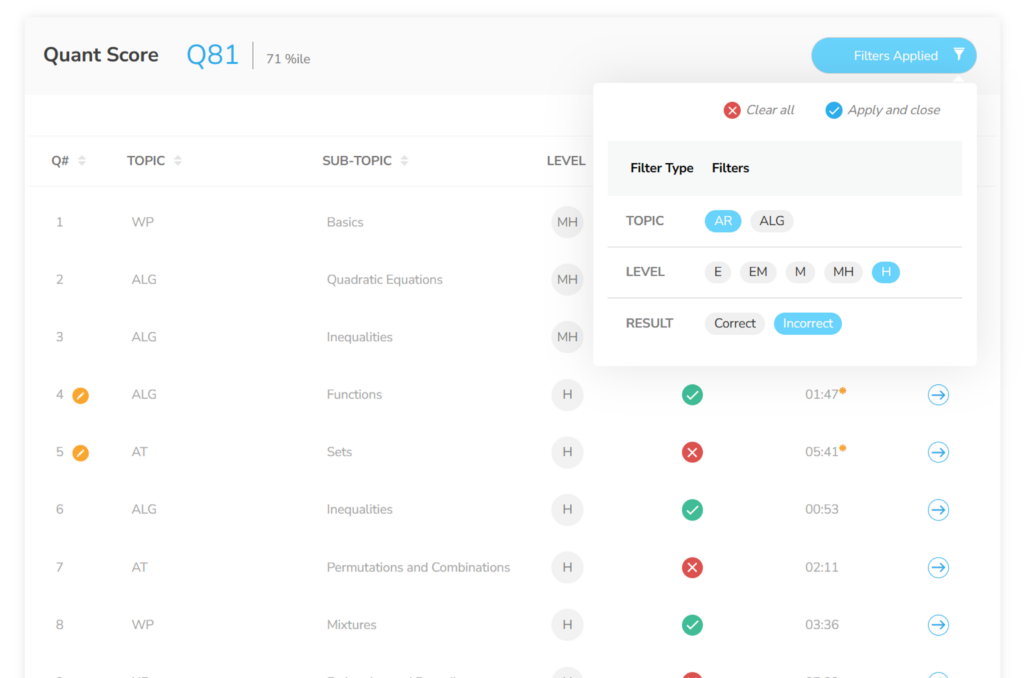
How do we facilitate this? By examining where mistakes occurred. To ensure this process is as efficient and effective as possible, we’ve equipped the test interface with a series of customizable filters. These filters grant students the ability to isolate and review their performance based on:
- Subsection: For instance, AR (Arithmetic) or ALG (Algebra).
- Difficulty Level: Spanning from E (Easy) to H (Hard).
- Response Result: Distinguishing between Correct and Incorrect answers.
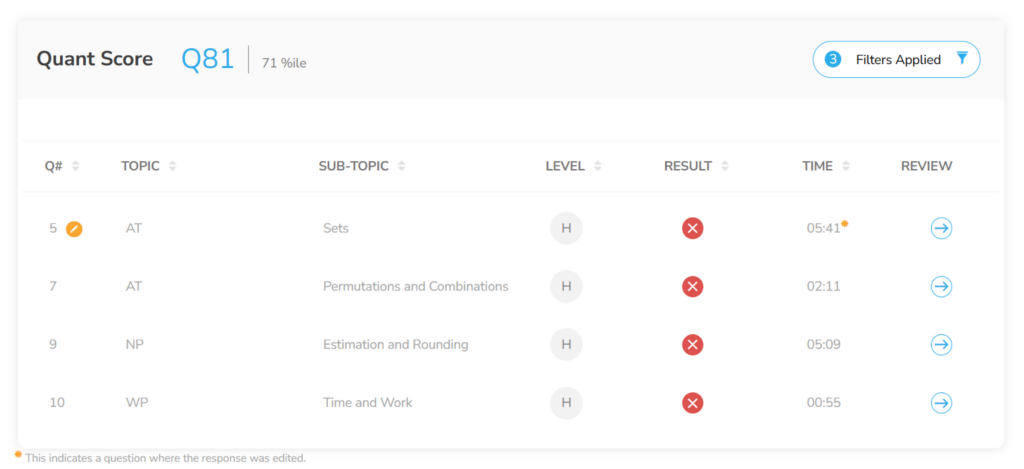
In Bethany’s recent mock test, with the filters applied, a clear pattern emerges from the Quant section. The data reveals errors in specific sub-topics:
- Advanced Topics (AT): Mistakes were made in ‘Sets’ and ‘Permutations and Combinations.’
- Number Properties (NP): ‘Estimation and Rounding’ posed a challenge.
- Word Problems (WP): The sub-topic ‘Time and Work’ was problematic.
To build on this detailed feedback, students can utilize the Scholaranium’s custom quiz engine. This engine allows Bethany and others to curate quizzes focusing exclusively on these identified areas. By honing in on these specific sub-topics and practicing, they can markedly elevate their accuracy and, by extension, their overall Quant score.
With such data-driven insights, students can adopt a more targeted approach in their preparation, ensuring they invest their time and efforts most effectively.
Comparing Sigma-X insights with insights provided by official mocks
Overall, official mocks provide a wealth of diagnostic information, a lot more than that provided by the GCE mocks and the official test, including the ESR. SIGma-X GFE mocks go a even further in terms of providing actionable insights to students. The table below showcases how the insights provided by SIGma-x mocks compare to those provided by the official mocks.
| Insight | SIGma-X mock | Official Mock | How does it help students |
| Sectional Scores | ✅ | ✅ | It enables students to understand their current abilities in various sub-sections |
| Sectional gap | ✅ | ❌ | Students get a clear understanding of how much improvement they need in each section. |
| Sub-sectional abilities | ✅ | ✅ | Students understand where they faltered within a section. It helps them channelize their energy while crafting improvement plans. |
| Sub-sectional gap analysis | ✅ | ❌ | Students know how much they need to improve in a particular subsection to achieve their target sectional score. |
| Sub-sectional Accuracy Analysis | ✅ | ❌ | Students can estimate whether they lack conceptual understanding, standard application, or advanced application, further channelizing their energy |
Summary: A mock designed to Empower you
The primary aim of our meticulous analysis is to pave the way for students to chart their path to success. Knowledge is power, and in this context, the knowledge of one’s strengths and weaknesses becomes the cornerstone of strategic preparation. Through our systematic breakdown – from sub-sectional capabilities to detailed sub-topic insights – we hand over the reins to the student, enabling them to:
- Diagnose Areas of Concern: By assessing their performance against diverse metrics, students can pinpoint exact areas where they’ve stumbled and where there’s scope for elevation.
- Forge Personalized Improvement Plans: With the granular insights at their fingertips, students can draft a roadmap tailored to their unique needs. This bespoke strategy ensures that every minute spent in preparation has maximum yield.
- Monitor Progress with Precision: Once the plan is in action, students can continually gauge their progress, adjusting their strategy as needed. The ability to track improvements or identify persisting challenges ensures that the student remains agile in their approach, pivoting where necessary for optimal outcomes.
In essence, our system not only provides a mirror reflecting a student’s current abilities but also serves as a compass, guiding them toward their academic goals with clarity and confidence.
Click here to take a mock and take the system for a test drive!


